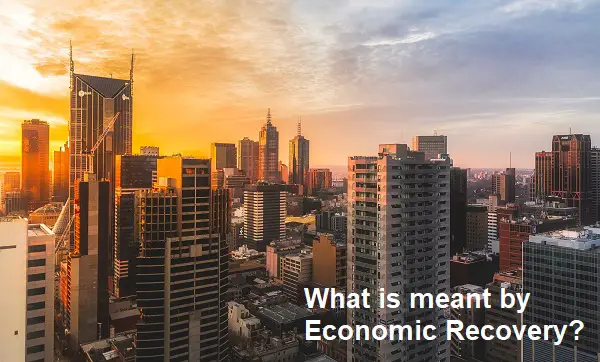Economic recovery is the process of recovering or improving a country’s economic condition after experiencing a crisis or downturn triggered by various things, such as economic crises, natural disasters, wars and the like, as well as recessions which are part of the business cycle. Each of these conditions creates a different economic situation so that the means or methods used in the context of economic recovery may vary.
The process of economic recovery from the crisis was carried out by taking various economic and fiscal policies needed to restore investor confidence, increase productivity and increase employment. These policies can take the form of high government spending, lower interest rates, or reduced taxes.
While the process of recovery or improvement of economic conditions after natural disasters, wars or other conflicts that disrupt economic activity. This process is usually carried out by taking certain policies to repair damaged infrastructure, return investment, and increase productivity.
While economic recovery which is part of the business cycle usually occurs naturally, where a country’s economy experiences increases and decreases within a certain period of time. However, to speed up the recovery process, the government sometimes issues the necessary economic policies to reduce the negative impact of these conditions.
Policies Commonly Used in the Economic Recovery Process
The following are several economic policies that can be implemented to accelerate economic recovery:
1. Increasing government spending: The government can spend more to repair damaged infrastructure, finance social programs, or provide economic stimulus in the form of providing cheap credit to companies affected by the crisis.
2. Lower interest rates: Central banks can lower benchmark interest rates to increase credit and investment. Lowering interest rates can also reduce the debt burden for companies and individuals.
3. Tax reduction: The government can reduce the tax burden on companies and individuals to increase purchasing power and increase investment.
4. Increased investment: The government can release funds to finance infrastructure projects or increase investment in certain sectors to increase productivity and employment.
5. Increasing exports: The government can also issue policies that support exports, such as reducing the tax burden on exporting companies, increasing the promotion of national products in international markets, or improving infrastructure that supports export activities.
6. Improving the quality of human resources: The government can issue policies that support improving the quality of human resources, such as education and training, to increase productivity and competence.
7. Improving technology: The government can also issue policies that support technology improvements, such as providing subsidies or incentives to companies that develop new technologies, so that the business sector is more advanced and productive.
8. Improving access to markets: The government also usually issues policies that support increased access to markets, such as providing tax rate concessions to companies that export, or opening up markets by entering into trade agreements with other countries.
9. Creating a conducive business climate: The government can issue policies that support improving a conducive business climate, such as reducing company operational costs, increasing access to capital, or reducing the tax burden.
10. Improve coordination between sectors: The government can issue policies that support increased coordination between sectors, such as improving infrastructure that supports export activities, or increasing access to markets.
The policies above can help accelerate economic recovery, but it must be remembered that each policy also has negative and positive impacts that must be taken into account. Therefore, these policies must be chosen and implemented carefully so as not to create new problems.
Impacts of Economic Recovery
The negative impacts of economic recovery on the people of a country can include:
* Decreasing inflation rates: High inflation rates can reduce people’s purchasing power, however, a rapid decline in inflation rates can also lead to lower prices for products and services, which in turn can reduce corporate income and reduce employment opportunities.
* Reducing the poverty rate: Economic recovery may indeed be able to increase employment and increase people’s income, so that it can reduce the poverty rate. However, there is a possibility that the policies taken to accelerate economic recovery may actually cause side effects, such as reducing subsidies or increasing the prices of basic products, thus burdening the less affluent.
* Lower interest rates: Lower interest rates can increase credit and investment, but can also reduce income for people who have savings or deposits in banks.
The positive impacts of economic recovery on the people of a country may include:
* Increased employment: Economic recovery can increase employment through increased investment and productivity in the business sector.
* Increased income: economic recovery can increase people’s income. Because there are many new jobs that are sufficient for everyone.
* Increased purchasing power: increasing practical income will also increase people’s purchasing power by reducing the inflation rate and increasing income.
* Increasing the level of prosperity: economic recovery can increase the level of community prosperity.
* Increasing the level of confidence: economic recovery can increase the level of public confidence in the economy, so that public consumption will increase and help the economy grow faster.
Example of Economic Recovery when Financial Crisis 2007-2008
The United States responded to the Financial Crisis by cutting interest rates to near zero, buying back mortgages and government debt, and bailing out some distressed financial institutions. With interest rates too low, bond yields are less attractive to buyers than stocks. The government’s reaction fueled the stock market, with the S&P 500 returning 250 percent over a ten-year span. The housing market in most of the major cities in the United States recovered, and the unemployment rate slumped as companies began to hire and spend more.
Other central banks reacted similarly to the United States. All governments increase their spending to spur demand and keep jobs in the economy; collateralized deposits and bank bonds to increase interest in financial companies; and buying equity stakes in several banks and other financial institutions to avoid bankruptcy, which may have intensified the financial market crisis.
Despite the fact that the world economy was in its most severe recession since the Great Depression, policy responses avoided a global depression.
As a result of the recession, authorities have tightened supervision of banks and other financial institutions. Among several recent global regulations, banks must now analyze the value of the loans they provide more carefully and use more resilient sources of financing.
The adoption of the Dodd-Frank Wall Street Regulation and Consumer Protection Act, major pieces of financial reform legislation enacted by the Obama administration in 2010, was one result of the crisis. Dodd-Frank changed every part of the United States financial regulatory system, affecting every regulatory agency and every financial services company.









